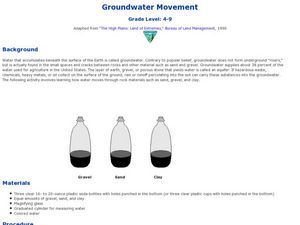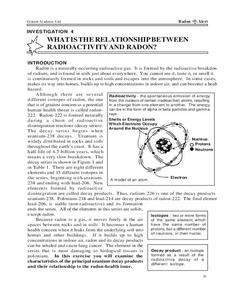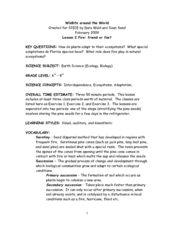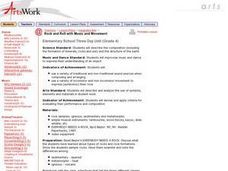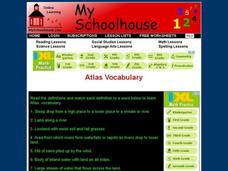Curated OER
Rocks and Minerals
First graders examine different types of rocks and minerals. They create models of the rocks and minerals they find interesting. They discuss and explain three ways in which the earth changes.
Curated OER
Groundwater Movement
Students study groundwater movement beneath the surface of the Earth. In this agriculture lesson, students experiment with how water moves through rock materials such as sand, gravel, and clay.
Curated OER
This Mine of Mine
Students explore natural resources by conducting a geology experiment in class. For this mineral mining lesson, students discuss the types of geological material that can be found when mining and the uses for these resources such as...
Curated OER
It's All About the Roots
Students investigate the process of hydroponic agriculture. They grow beans in different hydroponic solutions, compare results and graph their observations.
Curated OER
One Part A Mini Lab: Water Contamination
Students investigate the effects of ground water contamination. In this ground water contamination lesson plan, students create a mini well and simulate ground water flow through the well with a contaminate (food coloring). They make...
Curated OER
What is the Relationship Between Radioactivity and Radon?
In this radon and radioactivity worksheet, high schoolers analyze the data of the isotopes of elements that occur in the decay series of uranium-238. Students answer 6 questions about the isotopes, their half-lives, their potential...
Curated OER
How Much is Dirt Worth?
Fourth graders graph the percentages of the materials that make up the Earth and complete computations based on their results. In this topsoil lesson, 4th graders diagram the different layers of Earth's composition.
Curated OER
Wildlife Around the World
Students examine how plants are able to adapt to their ecosystem and the role that fire plays in changes through the years. In this ecosystem lesson students complete several exercises focussing on plants and their adaptations to.
Curated OER
Earthworm Animation
Students use animation to create their own earthworm catching and eating its prey. They must draw storyboards before they start on the animation.
Curated OER
How Long Until Dirt
Third graders examine the difference between composting and wasting food. They problem-solve what to do about leftovers after lunches so good food doesn't go to waste.They study food storage techniques that are environmentally friendly...
Curated OER
Acid Rain
Students understand the dynamics of acid rain and its impact on the living and non-living environment. They hypothesize how acid rain affects water pH levels in two lake systems with differing watershed features.
Curated OER
Types of Weathering
In this weathering worksheet, high schoolers compare the two types of weathering: mechanical and chemical. This worksheet has 11 matching questions.
Curated OER
Diaper Challenge
Learners compare the absorbency of a regular diaper and a swim diaper in fresh water and salt water. In this absorbency lesson plan, students mass the diapers and place them in water and determine the change in mass. They do the same...
Curated OER
Sense of Place
Students identify the major folk regions of Louisiana and the relationship between folklife, geography, and ecology. They give deeper thought to what makes their own community unique, what their sense of place actually is. Students...
Curated OER
Rock and Roll with Music and Movement
Fourth graders improvise music and dance to express their analysis of types of rocks. They discuss the three classes of rocks, list describing words, and create a short musical piece and dance to symbolize the rock they are dancing.
Curated OER
Bog Science
Students study bogs. They tour, collect physical, chemical, and biological data and analyze a pristine bog community. Using the data, they draw a map and a cross section of the bog.
Curated OER
Find Yourself with Global Positioning
Students examine different types of new mapping technologies. They use the internet to gather information about mapping and navigation. They create their own global positioning tool and defend it to the class.
Curated OER
Volcanic Activity in the U.S.
Students locate and map ten volcanoes in United States, create chart comparing volcanoes by last eruption, type of volcano, location, and interesting fact, and create Powerpoint slide show describing basic
information about volcanoes and...
Curated OER
To Eat or Not to Eat?
Learners identify various parts of plants and determine which parts people eat. They conduct a celery stalk experiment in which they determine the value and use of the stem, and how it helps the plant to meet its needs. Students use a...
Curated OER
Understanding How Potatoes Grow
Second graders make a KWL chart and brainstorm what they need for the project of growing potatoes. They choose one potato and plant it in water or peat moss cups and choose a location in which meets the needs of the plants and make their...
Curated OER
Weathering Walk
In this weathering worksheet, students walk around campus and observe ten examples of both mechanical and chemical weathering. They answer questions related to their observations.
Curated OER
The Magic School Bus Wet All Over
Students observe the water cycle and experiment with cleaning water. In this hands-on hydrology lesson based on a Magic School Bus book, students conduct two experiments to see the how water moves through the water cycle and then they...
Curated OER
Atlas Vocabulary
In this atlas terms and definitions online interactive worksheet, students read the definitions and match them with Atlas vocabulary words. Students match 49 answers.
Biology Junction
Segmented Worms - The Earthworm
In this biology worksheet, students color and label the different parts of an earth worm. They complete 41 short answers and fill in the blank questions about earthworms.
Other popular searches
- Weathering and Soil Formation
- Land Formations Soil
- Rocks and Soil Formation
- Erosion and Soil Formation
- Soil Formation Video
- Process of Soil Formation
- Stages of Soil Formation
- Elementary Soil Formation
- Formation of Soil
- Soil Formation and Profile
- Soil Formation and Composition

